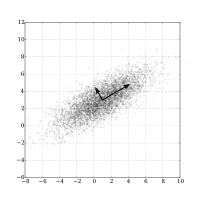
Photo from wikipedia
Familial relatedness (FR) and population structure (PS) are two major sources for genetic correlation. In the human population, both FR and PS can further break down into additive and dominant… Click to show full abstract
Familial relatedness (FR) and population structure (PS) are two major sources for genetic correlation. In the human population, both FR and PS can further break down into additive and dominant components to account for potential additive and dominant genetic effects. In this study, besides the classical additive genomic relationship matrix, a dominant genomic relationship matrix is introduced. A link between the additive/dominant genomic relationship matrices and the coancestry (or kinship)/double coancestry coefficients is also established. In addition, a way to separate the FR and PS correlations based on the estimates of coancestry and double coancestry coefficients from the genomic relationship matrices is proposed. A unified linear mixed model is also developed, which can account for both the additive and dominance effects of FR and PS correlations as well as their possible random interactions. Finally, this unified linear mixed model is applied to analyze two study cohorts from UK Biobank.
Journal Title: Genetic Epidemiology
Year Published: 2020
Link to full text (if available)
Share on Social Media: Sign Up to like & get
recommendations!